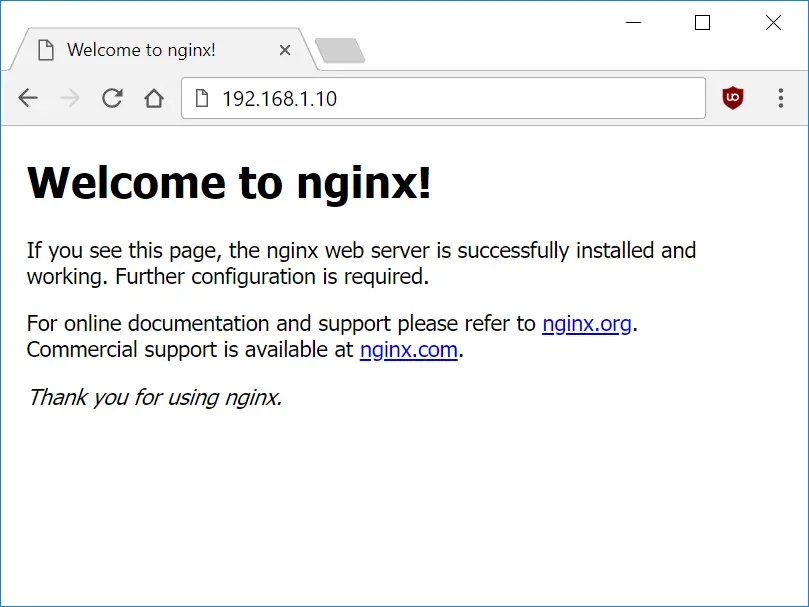Installing Nginx on Ubuntu 18.04 with Multiple Domains
1. Install Nginx
Let’s begin by updating the package lists and installing Nginx on Ubuntu 18.04. Below we have two commands separated by &&. The first command will update the package lists to ensure you get the latest version and dependencies for Nginx. The second command will then download and install Nginx.
sudo apt update && sudo apt install nginxOnce installed, check to see if the Nginx service is running.
sudo service nginx statusIf Nginx is running correctly, you should see a green Active state below.
● nginx.service - A high performance web server and a reverse proxy server
Loaded: loaded (/lib/systemd/system/nginx.service; enabled; vendor preset: enabled)
Active: active (running) since Mon 2018-05-14 23:03:47 UTC; 16s ago
Docs: man:nginx(8)
Process: 13003 ExecStart=/usr/sbin/nginx -g daemon on; master_process on; (code=exited, status
Process: 12994 ExecStartPre=/usr/sbin/nginx -t -q -g daemon on; master_process on; (code=exite
Main PID: 13006 (nginx)
Tasks: 2 (limit: 1153)
CGroup: /system.slice/nginx.service
├─13006 nginx: master process /usr/sbin/nginx -g daemon on; master_process on;
└─13009 nginx: worker process2. Configure Firewall
If you haven’t already done so, it is recommended that you enable the ufw firewall and add a rule for Nginx. Before enabling ufw firewall, make sure you add a rule for SSH, otherwise you may get locked out of your server if you’re connected remotely.
If you get an error “ERROR: could find a profile matching openSSH”, this probably means you are not configuring the server remotely and can ignore it.
Now add a rule for Nginx.
Enable ufw firewall.
Now check the firewall status.
That’s it! Your Nginx web server on Ubuntu 18.04 should now be ready.
4. Test Web Server
Go to your web browser and visit your domain or IP. If you don’t have a domain name yet and don’t know your IP, you can find out with:

You can find this Nginx default welcome page in the document root directory /var/www/html. To edit this file in nano text editor:
To save and close nano, press CTRL + X and then press y and ENTER to save changes.
Your Nginx web server is ready to go. You can now add your own html files and images the the /var/www/html directory as you please. However, you should acquaint yourself with and set up at least one Server Block for Nginx as most of our Ubuntu 18.04 guides are written with Server Blocks in mind.
Server Blocks allow you to host multiple web sites/domains on one server. Even you only ever intend on hosting one website or one domain, it’s still a good idea to configure at least one Server Block.
5. Configure Server Blocks
If you wish to host multiple sites/domains on Nginx, you should now set up your directory structures and Server Blocks. Even if you only want to host one site/domain, it’s a good idea to set up a directory and Server Block now because if you ever need to add a new domain later, it will makes things a lot easier for you.
For the purposes of this guide, we will make a Server Block for mytest1.com and another for mytest2.com. You can substitute these with your own registered domains, or if you don’t have any domains yet, you can still follow this guide and add mytest1.com and mytest2.com to your hosts file to trick your OS into resolving these domains in the browser. We’ll explain how to do this at the end of the guide.
5.1. Create Directories and Set Permissions
Let’s create two new directories in the /var/www/ directory for our two domains.
If we want our regular non-root user to be able to modify files in these directories, we must change the ownership.
The $(whoami) variable will take the value of the user you are currently logged in as.
We must also make sure the permissions for the general web directory /var/www and its contents are set to 755 so that pages can be served correctly.
5.2. Create Test Web Pages
We’ll now create a simple index.html web page for each domain using the echo command.
Don’t forget to replace mytest1.com with your own domain here if you have one.
Now do the same for mytest2.com.
5.3 Create the First Server Block
Nginx contains a default server block in /etc/nginx/sites-available/default which we can use as a template for our own server blocks.
Copy this file to a new file named after your domain. In this example, mytest1.com
Now edit the file you just copied:
Scroll down and look for the line root /var/www/html;. (You can use CTRL + W to search).
Change this root to the path of the directory you created earlier. In our example, /var/www/mytest1.com/public_html
/etc/nginx/sites-available/mytest1.com
Now look for the line server_name _;. (You can use CTRL + W to search).
Change this to your domain name. In our example, mytest1.com. We will also add www. here as well.
/etc/nginx/sites-available/mytest1.com
Save and close nano (Press CTRL + X and then press y and ENTER to save changes)
Ensure the Nginx config file syntax is valid before continuing to the next step. If there is an error in your syntax and you restart Nginx, you can crash the web server.
If syntax is valid you should see:
5.4 Create the Second Server Block
We will now create a server block for our other domain name, in this example, mytest2.com.
The only difference between this step and the last is the removal of default_server from the listen directive in the config file. You can only have one default_server – if you have two, the web server will not start.
Firstly, let’s copy the default server block in /etc/nginx/sites-available/default. Copy this file to a new file named after your domain. In this example, mytest2.com
Now edit the file you just copied.
Scroll down to the listen directive.
/etc/nginx/sites-available/mytest2.com
Only one server block can have the default_server specification. This tells Nginx which block to revert to if the server_name requested does not match any of the available server blocks.
Remove default_server from the listen directive so it looks likes this.
/etc/nginx/sites-available/mytest2.com
Next, scroll down and look for the line root /var/www/html;. (You can use CTRL + W to search).
Change this root to the path of the directory you created earlier. In our example, /var/www/mytest2.com/public_html
/etc/nginx/sites-available/mytest2.com
Now look for the line server_name _;. (You can use CTRL + W to search).
Change this to your domain name. In our example, myest2.com. We will also add www. here as well.
/etc/nginx/sites-available/mytest2.com
Save and close nano (Press CTRL + X and then press y and ENTER to save changes)
Ensure the Nginx config file syntax is valid before continuing to the next step. If there is an error in your syntax and you restart Nginx, you can crash the web server.
If syntax is valid you should see:
6. Create Symbolic Links
We will now create symbolic links from the sites-available directory to the sites-enabled directory, which Nginx reads during startup. Be sure to replace mytest1.com and mytest2.com with your own domains if you have them.
We also have to remove the symbolic link for the default server block, otherwise it will interfere with our two new ones.
Now restart Nginx.
7. Test Nginx
Assuming you have already configured DNS on your domain registrar to point your domains to the IP of your Nginx server, you should now be able to view these test web pages in the browser. If you don’t have any domains and just want to test mytest1.com and mytest2.com, continue to the next step.

8. Edit Hosts file (optional)
If you do not have any domains registered and instead just want to load mytest1.com and mytest2.com as a test, you can edit the hosts file in your OS to point these domains to your server.
To edit hosts file , run sudo nano /etc/hosts.
hosts
Replace x.x.x.x with your web server’s IP.
If you don’t know your web server’s IP, you can find out with:
Once you’ve saved you hosts file, you should be able to access mytest1.com and mytest2.com in your browser.
Last updated
Was this helpful?